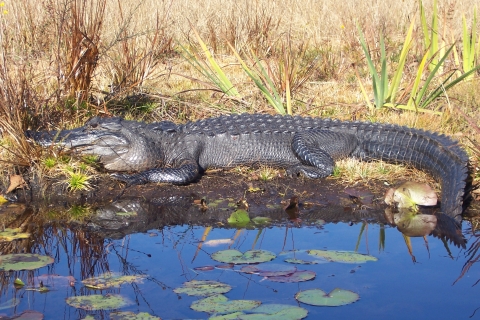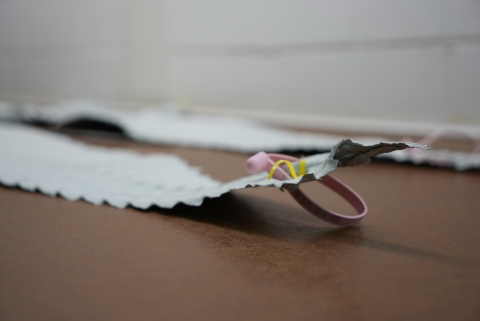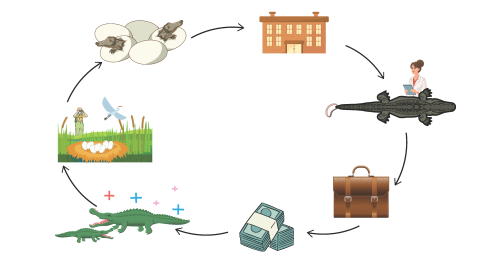It may be hard to believe that what once drove the American alligators to the brink of extinction is now the mechanism that helps the species thrive: the market for leather goods. Today, their populations are healthy in the Southeast United States, and a sustainable trade system incentivizes the conservation of alligator habitat.
Throughout history, alligator leather has been used for boots, belts, and other luxury goods. However, demand for this leather eventually overtook supply. By the 1960s, the population was so depleted that seeing a live American alligator in the wild became a rarity.
In response, the home states of these giant reptiles enacted bans on hunting. Eventually, alligator numbers declined to the point that the species needed Federal protection, initially through the Endangered Species Preservation Act of 1966 and under the Endangered Species Act of 1973 (ESA). The ESA stopped commercial trading of any American alligator product.
These state and Federal protections allowed alligators to rebound. By 1979, we determined the population could now support limited commercial trade, and American alligators were included in Appendix II of the Convention on International Trade in Endangered Species of Wild Fauna and Flora, known as CITES. This meant that alligator products could be traded internationally but only in a way that is biologically sustainable, legal, and traceable. By 1987, the American alligator had recovered enough to no longer require an “endangered” or “threatened” status but was kept on CITES Appendix II and on the ESA due to its similar appearance to other threatened crocodilian species.
Today, American alligators have recovered across the U.S. Southeast and now support a market that is closely regulated. Through the traceable commerce of American alligator under CITES, the United States ensures that the number of alligators and eggs taken does not negatively impact the wild alligator population. This creates a biologically sustainable resource that fuels economies in places where there are few other opportunities for sustainable livelihoods, incentivizes the enhancement of wetland habit for many species, and creates a unique revenue source for the United States.
To facilitate this biologically sustainable trade, our International Affairs program established a co-management program for states and Tribes as part of our CITES Export Program.
“I think without the CITES program there would be confusion, and chaos throughout the commercial sector of the wildlife trade.” - Christy Plott Gilmore, Louisiana Alligator Advisory Council, CITES Consultant
The CITES Export Program helps to streamline the normal permitting process for those seeking to efficiently export products for certain native species. Currently, nine U.S. states are enrolled in the CITES Export Program for American alligator and routinely conduct surveys for alligator population numbers status.
States submit annual reports to us that share information on harvest levels, alligator populations, and any changes in their regulations. Based on this information, our International Affairs program conducts evaluations called non-detriment findings to ensure that the take of alligators will not have a negative impact on the population of wild alligators, per state.
We also make an evaluation called a legal acquisition finding, which is required for any export of alligator skins outside of the United States. Alligator “tags” are critical to fulfill this finding, which is required by international law. For states that are in the CITES Export Program, state officials order specialized tags from us to attach to alligator skins at the time of harvest. This signifies that the skins were acquired legally, as part of this closely monitored program. The CITES Export Program and its tags are vital for ensuring traceability for legally taken skins and streamlines the permitting process.
The Power of a Tag
For designer goods companies, the presence of a CITES tag on an alligator skin not only ensures that the animal was taken legally, but it can even help during skin processing (e.g., tracking which skins are in the same color batch). If an alligator skin does not have a CITES tag, it cannot be exported from the United States and tanning companies will often not work with skins that do not have tags.
The CITES Export Program (and its tagging requirements) helps facilitate the trade of alligator skins in a way that is legal, traceable, and biologically sustainable. The skins bring in revenue to communities in the southern U.S., further incentivizing promotion of alligator populations through preservation of alligator habitat. Healthy alligators help support a healthy local economy.
Gator Gold
The international trade of alligator skins can exceed one billion dollars annually, supporting livelihoods and local economies. Wild alligators can be obtained as adults or as eggs, depending on the state. In Louisiana and several other states, alligator egg collectors pay landowners for access and egg collection rights. They supply eggs to alligator farms, who then supply alligator skins to tanning facilities. These facilities sell processed skins to luxury goods manufacturers. Additionally, alligator farms can sell alligator manure to local agricultural farms.
Every step in the alligator trade chain creates jobs. “It’s very important for the local economy and the greater economy in Georgia,” said Kara Nitschke, wildlife biologist with Georgia Wildlife Resources. “It provides a lot of jobs for folks in rural areas and also puts Georgia on the map as a leader in the farmed alligator hide industry.”
The Service, in partnership with states, supports local economies through the biologically sustainable harvest of American alligator. State herpetologists create contracts with egg collectors, limiting how many eggs can be taken from the wild. They also distribute the CITES tags, so that when it is time to export skins internationally, our Office of Law Enforcement can check tag numbers by state before the skins are shipped internationally.
“American alligators are iconic American species that have healthy wild populations due to our work done in collaboration with state and local partners. Together, we have created a management system that preserves the species and supports sustainable international trade.”-Hila Levy, Assistant Director for International Affairs
The financial gain from the alligator trade has also incentivized wetland habitat preservation. Jeb Linscombe, alligator coordinator with Louisiana Department of Wildlife and Fisheries, explained that revenue from alligators harvested in the wild, as well as from alligator eggs collected, "incentivized landowners to not only manage alligators properly but actually manage the wetlands in a way that would benefit not just alligators but hundreds of other species.”
A Positive Feedback Loop
From egg collectors to farm workers, tanneries to international designers, through collaboration and the CITES Export Program, the trade in American alligator skins supports a sustainable economy that can benefit the United States for years to come.
Learn more about our CITES Export Program and our conservation permitting program: https://www.youtube.com/watch?v=SWdhccw-Xek








